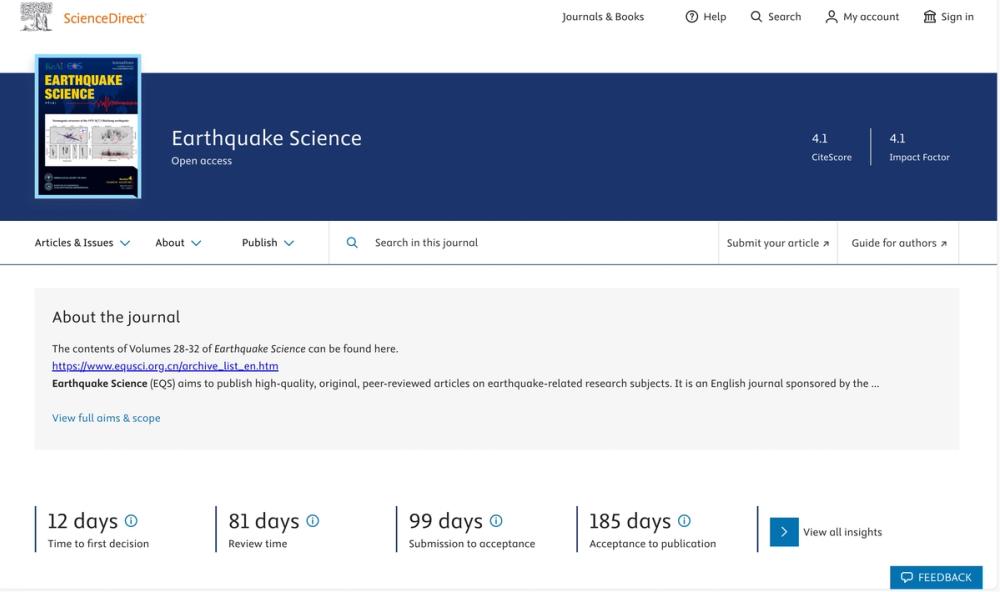Name: Earthquake Science
Link: www.equsci.org.cn
Description: Earthquake Science is a peer-reviewed, open-access journal publishing high-quality original research and reviews on earthquake-related topics, sponsored by the Seismological Society of China and the Institute of Geophysics, China Earthquake Administration.
Key Words: earthquake science, seismology, peer-reviewed, open access, seismic hazards, seismotectonics, ground motion, earthquake prediction
Introduction:
Earthquake Science (EQS) is a leading international English-language journal dedicated to advancing the understanding of earthquake phenomena through high-quality, peer-reviewed research. Published by the Seismological Society of China (SSC) and the Institute of Geophysics, China Earthquake Administration (IGPCEA), the journal was established to provide a platform for scientists and researchers worldwide to share original research, reviews, and technical notes on earthquake-related subjects. Since its inception, it has grown into a respected outlet for cutting-edge studies in seismology and related disciplines, with a focus on fostering global collaboration and knowledge exchange.
The journal’s scope is broad, encompassing a wide range of earthquake-related topics, including seismic sources, earth structure at various scales, seismotectonics, theoretical seismology, strong ground motion, seismic hazards, earthquake forecasting and prediction, seismic instrumentation, and documentation of significant seismic events. It also welcomes contributions on new methods, field deployments, and software tools that enhance earthquake research. This interdisciplinary approach encourages submissions from fields such as geology, geophysics, geodesy, rock physics, and earthquake engineering, ensuring a comprehensive exploration of seismic phenomena.
Earthquake Science is committed to open-access principles, making its content freely available to a global audience, which enhances its reach and impact. The journal operates under a rigorous peer-review process to ensure the publication of scientifically robust and innovative research. Authors are encouraged to provide detailed methodologies, data availability statements, and supplementary materials to support reproducibility and transparency, aligning with modern open science practices. The journal also emphasizes the importance of high-resolution studies, such as those involving ambient noise tomography, seismic velocity structures, and probabilistic seismic hazard analysis, as seen in recent articles like those exploring the 1975 Haicheng earthquake and the 2024 Feidong M4.7 earthquake.
Published quarterly, Earthquake Science has been a key resource since its founding, with archives of volumes 28–32 accessible online (https://www.equsci.org.cn/archive_list_en.htm). It is particularly noted for its focus on seismic events in China, such as the 2015 Gorkha earthquake and the 2025 Xizang Dingri M6.8 earthquake, while also addressing global seismic research. The journal’s editorial board includes prominent seismologists, and it is supported by the SSC, a nonprofit organization founded in 1979 with over 3,000 members, and the IGPCEA, a leading geoscience institution established in 1950. These affiliations underscore the journal’s credibility and its role in China’s national earthquake preparedness and disaster mitigation efforts.
Earthquake Science also supports special issues, such as those on electromagnetic phenomena related to seismic and volcanic activities, and encourages submissions that integrate advanced techniques like deep learning and full time-series inversion. By providing a platform for both fundamental and applied research, the journal contributes significantly to global efforts in understanding earthquake physics, improving seismic hazard mitigation, and advancing earthquake prediction methodologies. Its commitment to open access and rigorous standards makes it an essential resource for researchers, engineers, and policymakers working to reduce the societal impacts of earthquakes.




